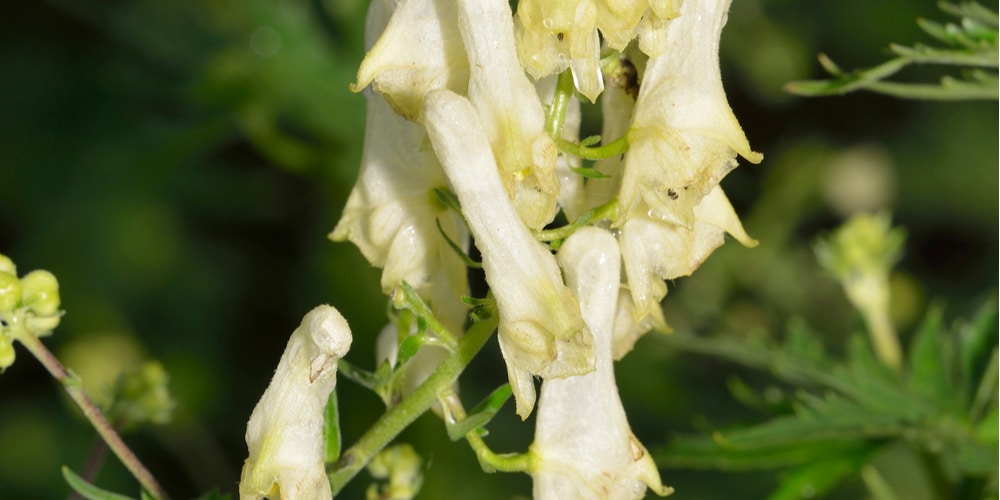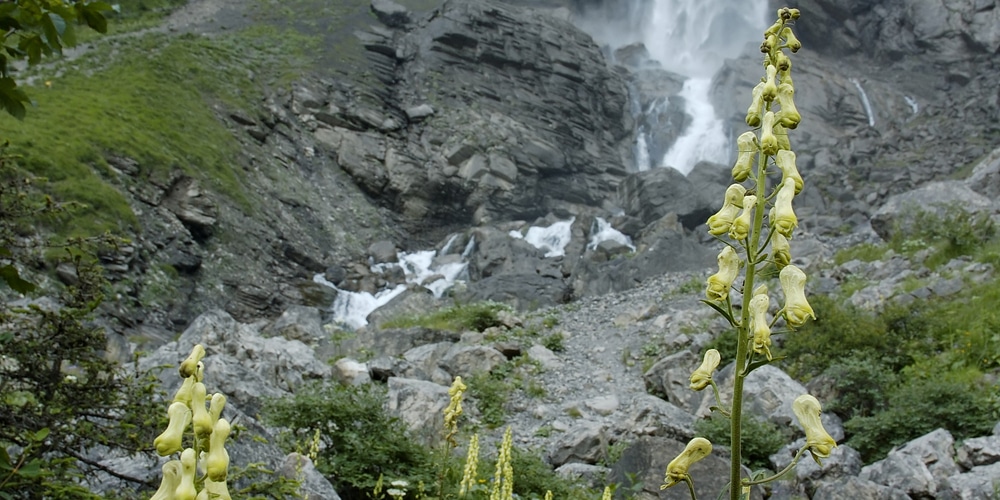Aconitum vulparia, also known as Wolf’s bane, is a stunning perennial with gorgeous blooms, perfect for adding a touch of color to your garden. The plant isn’t particularly challenging to grow.
Still, knowing its needs and requirements will help you make the most out of your delicate-looking flowering plant. If you would like to add this plant to your garden, look no further! You’ll find everything you need to know about growing a thriving wolf’s bane in this essential guide.

| Botanical Name | Aconitum vulparia |
| Common Name | Wolf’s Bane or Foxbane |
| Plant Type | Perennial |
| Flower Color | The white (or purple, depending on the variety) flowers grow on sturdy stems and are eye-catching, with five sepals each, narrow and oblong. |
| Size When Mature | Up to 5 ft tall and 2 ft wide |
| Bloom Time | Mid to late summer |
| Sun Requirements | Partial Shade |
| USDA Hardiness Zones | 4-8 |
| Soil PH Range | 5.0-6.0 |
| Soil Type | Moist, rich, well-draining. |
| Water Needs | Medium |
| Native Area | Europe and Asia |
What you Need to Know About Aconitum vulparia
Aconitum vulparia is a slow-grower that might take up to one year to sprout if you decide to start it from seeds. Still, it is a long-lived plant that will delight you with stunning flowers that will enrich the looks of your garden.
When healthy, wolf’s bane’s blooms are eye-catching and attractive. The blooming season starts in early summer and can continue until fall if the temperatures are ideal. Overall, wolf’s banes aren’t particularly challenging to grow.
Unfortunately, the plant is toxic to humans and animals. If you have curious kids or pets running around your garden, you should consider adding another species. Indeed, even handling might cause skin irritation or a mild allergic reaction. Don’t forget to wear gloves and protective equipment when pruning or touching it.
How to Care for Aconitum vulparia
As mentioned, aconitum vulparia doesn’t need much attention from your side. Once established, growing a thriving wolf’s bane won’t require much effort. However, knowing the needs and requirements of this plant might facilitate the process.
Light
To get the most out of the plant, choose a spot that receives sun in the morning. Afternoon shadow is ideal for protecting your plant from sunburn.
Partial shade will give you the best blooms, especially if you live in a region where summers are hot. Indeed, too much lighting might cause discoloration and other issues to your plant. Still, with proper watering, the plant can tolerate even full sun.
Water and Soil Needs
Wolf’s bane grows best in well-draining and fertile soil, better if slightly acidic. The ideal pH is between 5.0 and 6.0. Make the necessary amendments to accommodate the substrate to the plant’s needs.
If you decide to locate your plant under the full sun, you’ll have to keep the soil consistently moist. However, these plants don’t do well in soggy soil. Consider adding a layer of mulch around your plants to improve drainage and increase water retention.
In partial shade (and once established), this plant will tolerate short periods of drought. Still, it will grow healthier in moist conditions.
Temperature Requirements
Aconitum vulparia can thrive in USDA hardiness zones from 4 to 8. Keep in mind that the plant prefers cooler temperatures, so you should shelter it from the harsh sunlight of the afternoon during the summer. Besides that, your plant will adapt to most conditions.
Fertilizer
While fertilizer isn’t necessary, you might want to perform a soil test to investigate your substrate’s conditions. Amend the soil to increase the nutrient content by applying a high-quality product (better if slow-release). Don’t forget to follow the instructions you find on the labels to avoid harming your plant.
Common Diseases
Wolf’s bane rarely presents problems. Most animals tend to avoid it due to its toxicity. So, if you live next to a forest, you’ll most likely have to worry about deer or other mammals munching on it.
The plant is susceptible to bacterial leaf spots, rust, and verticillium wilt. Keep the plant moist but avoid overwatering to prevent severe issues.
Aconitum vulparia Propagation
You can propagate aconitum vulparia by seeds. However, keep in mind that the process can be tricky (and time-consuming). Consider sowing the seeds in the fall and transplanting them to a permanent location when they start growing into seedlings.
Related article: Flowers That Start with A

